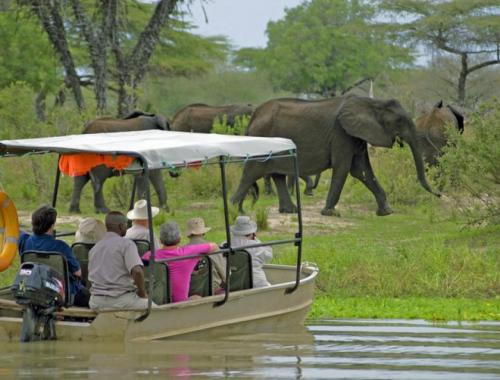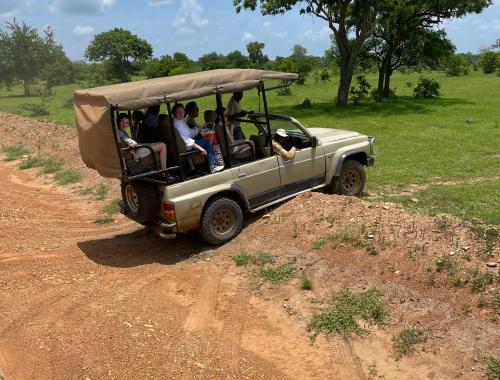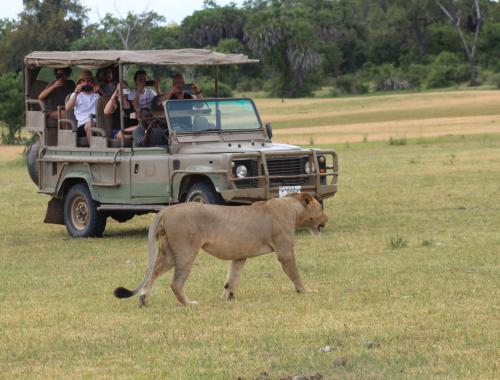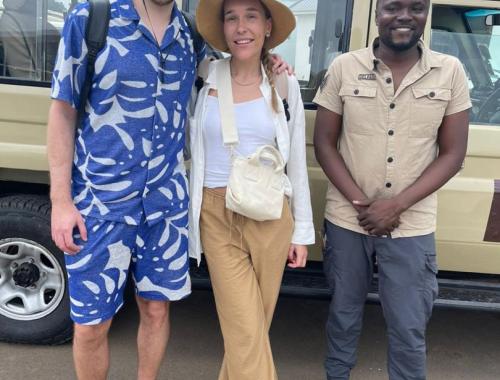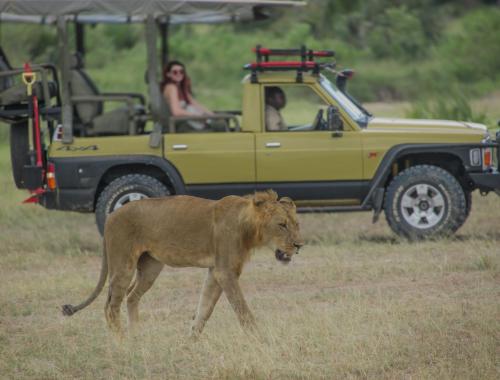Nyerere National Park
Nyerere National Park (formerly Selous Game Reserve) is one of the largest wildlife parks in Africa. It is found in southern Tanzania and covers a huge area of land. The park was named after Julius Nyerere, the first president of Tanzania. Before it became a national park in 2019, it was part of the Selous Game Reserve.
This park is home to many wild animals such as elephants, lions, giraffes, hippos, crocodiles, zebras, and wild dogs. It also has many birds and plants. The Rufiji River, the biggest river in Tanzania, flows through the park. It helps keep the land green and gives water to the animals.
Tourists can visit Nyerere National Park to go on safaris, take boat trips on the river, and enjoy the natural beauty. The park is very important for protecting animals and nature in Tanzania.
🦓 Quick Facts – Nyerere National Park (Tanzania)
📍 Location: Southern Tanzania
📅 Established: 2019 (carved from the Selous Game Reserve)
👤 Named After: Julius Nyerere, Tanzania’s founding president
📏 Size: Around 30,893 km² — almost the size of Belgium
🐘 Wildlife: Elephants, lions, leopards, giraffes, hippos, crocodiles, zebras, wildebeest, buffalo, wild dogs
🐦 Birds: Over 440 bird species
🌊 Major River: Rufiji River – famous for boat safaris and crocodile/hippo viewing
🛶 Activities: Game drives, boat safaris, walking safaris, birdwatching
🌿 Landscape: A mix of rivers, wetlands, forests, and open savannah
🚙 Access: Can be reached by road from Dar es Salaam (about 6–7 hours) or by small aircraft
🏕️ Accommodation: Various safari camps and lodges, from budget to luxury
🔒 Conservation Role: Important for protecting endangered species like the African wild dog
☀️ Best Time to Visit: June to October (dry season – great for wildlife viewing)
🕰️ History of Nyerere National Park
Nyerere National Park has a long and important history. Before it became a national park, it was part of the Selous Game Reserve, which was one of the largest protected areas in Africa. The Selous Game Reserve was created in 1922 by the British colonial government to protect wildlife and control hunting.
The reserve was named after Frederick Selous, a famous British explorer and hunter. He loved African nature and animals, and he died during World War I in this area. Over the years, Selous Game Reserve became famous for its large number of elephants, lions, hippos, crocodiles, buffalo, and other wild animals.
In 2019, the government of Tanzania decided to split the northern part of the Selous Game Reserve and turn it into a new national park. This park was named Nyerere National Park, in honor of Julius Nyerere, the first president of Tanzania and a strong supporter of nature conservation.
The goal of creating this park was to:
✅ Improve wildlife protection
✅ Promote tourism in southern Tanzania
✅ Attract investment in eco-friendly lodges and jobs for local people
✅ Stop illegal hunting (poaching) and better manage natural resources
Today, Nyerere National Park is one of the largest national parks in Africa, covering about 30,893 square kilometers. It is even bigger than many countries!
The park is full of different landscapes—rivers, wetlands, grasslands, and forests. The Rufiji River, the biggest river in Tanzania, flows through the park. This river gives water to animals and is great for boat safaris, where visitors can see hippos, crocodiles, and birds up close.
The park is now a popular tourist destination. People from around the world come to enjoy its wild beauty, take part in safaris, and learn about Tanzania’s natural heritage. It also creates jobs for local communities and helps teach people about protecting the environment.
Why Nyerere National Park Is So Special?
Nyerere National Park is very special for many reasons. It is not just a place with wild animals—it is a unique and beautiful part of Tanzania. Here’s why:
🐘 1. One of the Largest Parks in Africa
Nyerere National Park is huge—it covers about 30,893 square kilometers. That makes it one of the biggest national parks in all of Africa. It is even bigger than some small countries!
🦁 2. Home to Many Wild Animals
The park has a large number of animals like:
- Elephants
- Lions and leopards
- Giraffes
- Zebras
- Buffalo
- Hippos and crocodiles
- African wild dogs (very rare)
- Over 400 types of birds
It is a great place to see animals in their natural home, not in cages.
🌿 3. Beautiful Nature and Landscapes
The park is full of different environments, such as:
- Rivers and wetlands
- Forests and savannahs
- Hills and open plains
The Rufiji River, the largest in Tanzania, flows through the park. You can even take a boat safari to see animals by the water.
🛶 4. Special Safari Experiences
In Nyerere National Park, visitors can enjoy:
- Game drives (driving to see animals)
- Boat safaris (watching animals from the river)
- Walking safaris (guided walks in nature)
Few parks in Africa offer all three safari types in one place.
🌍 5. Rich History and Conservation
The park was created from part of the old Selous Game Reserve, which started in 1922. In 2019, it became a national park named after Julius Nyerere, Tanzania’s first president. He loved nature and worked to protect it.
👣 6. Supports Local People
Tourism in the park helps bring jobs and income to nearby communities. Many local people work as guides, rangers, and staff at lodges and camps.
🌱 7. Less Crowded than Other Parks
Unlike some parks in the north (like Serengeti), Nyerere is less crowded. Visitors enjoy a more peaceful and quiet safari experience.
Activities in Nyerere(Selous) National park
Nyerere National Park is a fun place to see wild animals like elephants and lions. You can go on a car safari, boat ride, walk with a guide, or even fly in a hot air balloon. You can also go fishing, take photos, and visit a Maasai village. It’s a great place for adventure and nature.
🐘 Game Drives (Safari Drives)
You ride in a car with a guide and go into the wild to see animals. You might see:
- Elephants walking in groups.
- Lions resting under trees or hunting.
- Giraffes, zebras, and buffaloes eating grass.
- Many other animals like antelopes, wildebeests, and even wild dogs.
Most drives happen early in the morning or late in the afternoon because animals are more active when it's cooler. Guides know where to find the animals and will stop for you to take pictures.
🚤 Boat Safaris on the Rufiji River
You ride in a safe, open boat on the big Rufiji River. On the boat, you will:
- See many hippos in the water.
- Watch crocodiles resting on the riverbank.
- Enjoy beautiful birds flying or sitting on trees.
- Relax and enjoy the cool breeze.
Sunset boat rides are very popular. The orange sky and calm water look magical.
🚶 Walking Safaris
This is a slow walk through the bush (wild area) with a trained ranger and guide. You will:
- Learn how to track animals by looking at their footprints.
- Hear stories about plants and how animals live.
- See insects, birds, and plants up close.
It’s a quiet and exciting way to explore nature. Don’t worry—it's safe with trained guides.
🎈 Hot Air Balloon Rides
You go up in a big balloon early in the morning, just as the sun rises. From the sky, you can:
- See animals walking on the land below.
- Watch rivers, trees, and hills from high above.
- Take amazing photos from the air.
After the ride, you often get breakfast in the wild. It feels like a special adventure.
🎣 Fishing Safaris
Go fishing in the river with a guide. You can catch fish like:
- Tiger fish (they fight hard when hooked!)
- Catfish
It’s usually “catch and release,” so you put the fish back in the water after catching it. All the fishing tools are provided.
📸 Photo Safaris
If you love taking pictures, this safari is for you. A guide helps you find the best spots and animals to photograph. You’ll have time to:
- Set up your camera
- Wait for animals to come close
- Capture the perfect moment, like a lion yawning or an elephant walking through the grass
- Even phones can take great photos!
-
🏞️ Cultural Visits
- You can visit a Maasai village near the park. The Maasai are a famous group of people in Tanzania and Kenya known for their colorful clothes and long traditions. During your visit, you can:
- See how they build their homes
- Watch traditional dances
- Learn about their food, language, and daily life
It’s a fun way to learn about real Tanzanian culture.
Accommodation in Nyerere National Park
In Nyerere National Park, accommodation options suit different tastes and budgets, from luxury lodges to simple campsites. The luxury lodges offer spacious tents or rooms with modern amenities like hot showers, comfortable beds, and delicious meals, often including safari packages with guided game drives and boat trips. These lodges are usually located close to the Rufiji River or other key wildlife areas, giving guests stunning views and easy access to the best safari spots.
For travelers seeking a balance between comfort and adventure, mid-range camps and lodges provide cozy tents or cabins with basic but clean facilities, meals, and guided safari activities. These options are perfect for those who want to experience nature without giving up some comforts.
For the more adventurous, there are budget camping sites where you can set up your own tent or rent camping gear. These sites offer minimal facilities, such as shared toilets and cold showers, but give a true bush experience, including the sounds of wildlife at night.
Because Nyerere is a popular safari destination, especially during the dry high season (June to October), it is important to book accommodation early. Staying inside the park means you can start your morning game drives early and return late, increasing your chances to see wildlife in their natural habitat. Many lodges also provide additional activities like cultural visits to Maasai villages and fishing safaris.
June to October, offering the best wildlife viewing as animals gather around water sources during the dry season
Dry season (June to October): Warm, little rain, best for wildlife viewing, Wet season (November to May): Hot, heavy rain, great for birdwatching.




